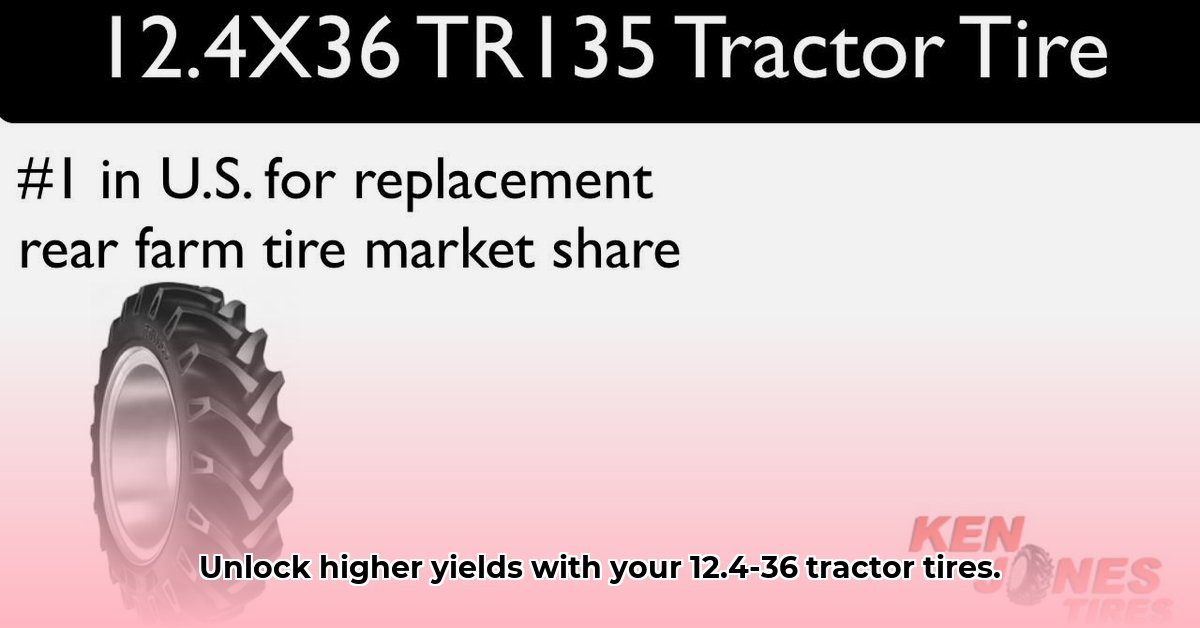
Choosing the right tractor tires is crucial for maximizing yields and adhering to sustainable farming practices. This guide focuses on the 12.4-36 tire size, providing a comprehensive understanding of its impact on soil health, fuel efficiency, and environmental sustainability. We'll explore tire specifications, sustainable practices, and a step-by-step guide to selecting the optimal tire for your farm. For more tire sizes, check out this helpful resource: other tractor tire sizes.
Understanding the 12.4-36 Tractor Tire
The 12.4-36 tire is a common size for smaller to medium-sized tractors. Its dimensions—diameter, width, and aspect ratio—directly influence its load-carrying capacity and ground contact area. Understanding these specifications is crucial for optimizing performance and ensuring efficient operation. Isn't optimizing tire performance key to maximizing your farming potential?
Proper tire inflation is paramount. Underinflation leads to increased soil compaction (the compression of soil particles, reducing pore space and hindering root growth), while overinflation reduces traction and increases wear. The recommended inflation pressure is typically found on the tire sidewall or in the tractor's owner's manual. Finding your tire's ideal inflation pressure provides the best balance of soil interaction and longevity.
The tread pattern significantly affects traction and soil interaction. Deep, aggressive treads provide superior grip in soft or muddy conditions, but may increase soil compaction. Conversely, shallower treads minimize compaction but may sacrifice traction. The choice depends on your soil type and farming operations. What tread pattern best fits your soil conditions?
The Impact of Tire Choice on Sustainable Practices
Sustainable farming prioritizes soil health, resource efficiency, and environmental protection. Tire selection plays a crucial role in all three aspects. Low Ground Pressure (LGP) tires, often available in 12.4-36, distribute the tractor's weight over a larger area, minimizing soil compaction. Isn't reducing soil compaction a cornerstone of sustainable agriculture?
Reduced compaction translates to improved soil structure, better water infiltration, and increased root growth. This leads to healthier crops and higher yields, as Dr. Emily Carter, Professor of Soil Science at the University of California, Davis, notes, "Minimizing soil compaction is critical to fostering beneficial soil microorganisms and ensuring water penetration for optimal plant growth. Selecting the appropriate tires is a key aspect of this practice."
LGP tires frequently contribute to greater fuel efficiency due to reduced rolling resistance. Lower fuel consumption translates to direct cost savings and a reduced carbon footprint for your farm. This decrease in both economic and ecological costs aligns perfectly with sustainable agriculture principles. Isn't fuel efficiency a vital component of environmentally responsible farming?
Choosing the Right Tire for Your Needs
Selecting the appropriate 12.4-36 tire requires careful consideration of several factors specific to your farm. Let's break down this process into a straightforward, actionable plan:
- Assess your soil type. Sandy soils benefit from deep treads for better grip, while clay soils may require wider treads to distribute weight effectively.
- Analyze your cropping system. Delicate root crops necessitate lower ground pressure tires to minimize compaction.
- Consider your farm's size and budget. Larger farms might opt for premium LGP tires due to long-term cost-benefit advantages while smaller farms might prioritize more affordable options.
Here's a simple decision-making table:
| Factor | Considerations |
|---|---|
| Soil Type | Sandy: Deep tread; Clay: Wide tread for weight distribution |
| Crop Type | Sensitive roots: Prioritize low ground pressure tires. |
| Farm Size/Budget | Large farms: Premium LGP tires; Small farms: Balance cost and longevity. |
Long-Term Considerations and Sustainability
The lifecycle of a 12.4-36 tire encompasses significant sustainability implications. Proper maintenance is key to extending its lifespan, minimizing waste and reducing the need for frequent replacements. Regular tire pressure checks and visual inspections for damage are crucial components of a sustainable tire management program.
Responsible disposal is another crucial consideration. Used tires should be recycled or repurposed whenever possible. Many organizations and tire retailers offer recycling programs that transform waste into useful resources. What environmentally friendly tire disposal options are available in your region?
Resources and Further Information
To expand your knowledge of sustainable farming practices and tire selection, consult resources from your local agricultural extension office, reputable agricultural universities (such as Cornell University's extension service), and government agencies like the USDA. These organizations provide valuable information and support for farmers seeking to enhance their sustainability practices.